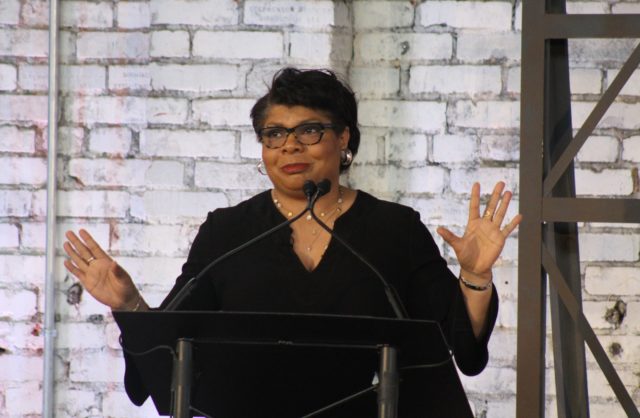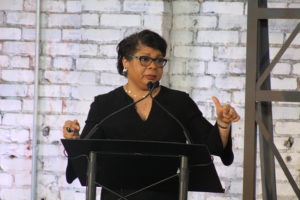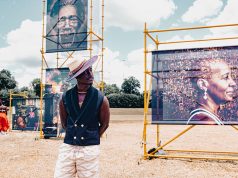
By Ameera Steward
The Birmingham Times
April Ryan, award-winning journalist, author and White House correspondent, was in Birmingham Monday and spent more than an hour talking about covering the President Donald Trump administration, black history and the power of helping others.
Ryan, who has covered four U.S. presidents for American Urban Radio Networks and provides commentary for CNN, was the guest speaker during Alabama Power’s “Power of Culture and Contribution” luncheon at The Theodore in Lakeview.
The program, during Black History month, focused on the contributions of African-American journalists.
Ryan spoke of how she was surprised to learn about diversity in the media when reading findings in the Kerner Commission report released in 1968 that came in the aftermath of inner-city riots. President Lyndon B. Johnson formed an 11-member panel – the Kerner Commission — that looked at race relations in America at the time.
“They had recommendations in that report . . . that happened to be about journalism,” she said. “How black people needed to be involved in journalism, at the highest spaces and places to shed a bright light on darkness. I said, ‘I guess I’m…one of the answers to the Kerner Commission report’, but yet there’s still a challenge to what we do.”
Ryan said she thinks about the challenges when the Kerner Commission was formed and challenges black journalists face today. “As a reporter who happens to be black, who covers all areas of news….today the challenge of freedom is still present…when you get to a place like that [covering the president of the United States], when you get to a position, you got to remember it’s about other people not about you,” she said. “Information is power, power is service.”
Making News
Ryan, who said she prefers to cover the news and not make it, was the focus of wide reporting after President Trump told her in November to “sit down” during a press briefing.
Ryan said on Monday when she asks questions, it’s not about her it’s about “us as a people. I’m just part of this great thing that our Founding Fathers created…when they created these wonderful pillars that we stand on, ‘we the people who are still forming a more perfect union.’”
She said the First Amendment, the freedom of the press, is one of those pillars.
“And I think about other pillars and markers in this nation as we celebrate Black History Month…are we in a time when we are able to recognize freedoms? Yes and no,” Ryan said. “You look down the street or around the corner and see all the (Civil Rights) markers from history and the Civil Rights Movement, but where are we today in 2019?”
Ryan said she felt a sense of history when she arrived in Birmingham to speak at Monday’s luncheon. “I came from the airport yesterday (Sunday) . . . [and] saw the Sixteenth Street Baptist Church [where four girls died in a 1963 bombing] and . . . I had to take a picture. That’s our history, whether you’re black, you’re white, or any race, religion, that’s our history as a people,” she said.
“I think about coming in on that drive and seeing that historic church. Those young girls went to church to praise God, their life was their service to us,” she said.
Interview The President

Ryan said she wants a one-on-one interview with President Trump.
“As a reporter you kind of want to know where a person’s mind is…and it kind of tells you why they make these decisions and how they think the way they think,” she said.
During a recent interview she asked the president about the impact of a government shutdown.
“You had people who were working and not getting paid…in some communities you had families who are actually all federal employees, they couldn’t borrow from one another….you got a lot of families that work in social security, work in a lot of federal agencies,” she said.
Moment In History
Ryan said she had a conversation with filmmaker Spike Lee and Karen Bass (D-California), Chair of the Congressional Black Caucus, “and we were just talking about this moment in history…Spike Lee made us call out a year and he’s right we need to start talking about it. 1619…400 years ago this year the first slaves were brought to this country.”
Ryan asked her audience to think where blacks are in 2019.
“In 2019 when you think about power…we got all our rights, we got freedoms, we got laws but we’re still dealing with issues,” she said.
Growing Up
As a child growing up in Baltimore, Ryan said she remembers her mother telling about those who served in the 50s and 60s. So many people gave “so we can be in this room, communing together.”
She lived Black History Month everyday of the year because her mother never missed the opportunity to tell her what black person invented what, Ryan said.
But covering the White House has allowed her to see history up close.
“What really gets me is what comes full circle, is that I was able, on the 50th anniversary (of the Marches from Selma to Montgomery) to come back to a place that I’ve never seen physically with my own eyes but saw on TV….but I have hope. I have hope in the power of people, the service of others,” she said.
There’s a spirit to not go backwards, she said, recalling the history of having the first black president, flying on Air Force One, landing in Birmingham, heading to Selma and seeing the streets lined with “people who look like me, young African-Americans…just wanting a glimpse of the White House brought tears to my eyes.”
Ryan continued by saying what struck her was the fact that if you took a picture of the Edmund Pettus Bridge, it looked the same as it was back then during the marches. She added, “but there’s progress.”




